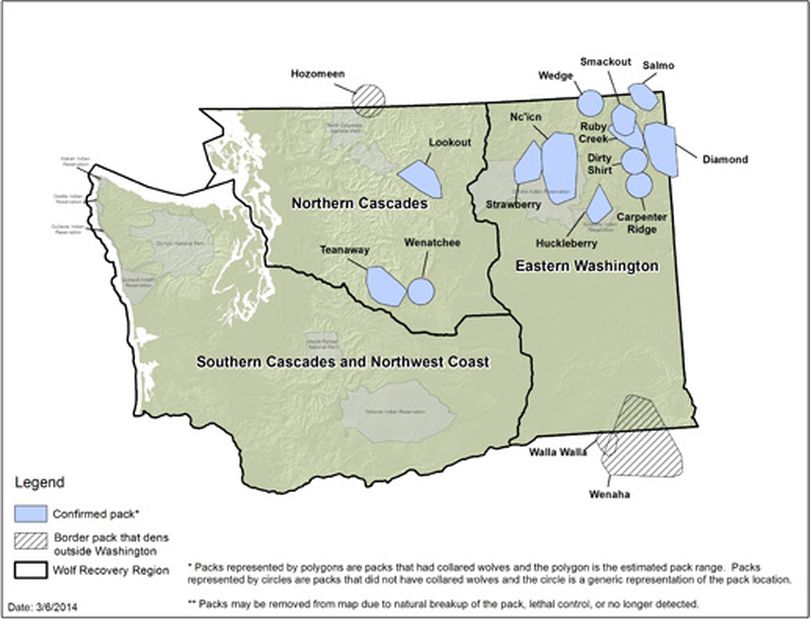Associated Press gets C-minus grade for wolf status reporting

ENDANGERED SPECIES -- The Seattle Bureau of the Associated Press copied a line from a Defenders of Wildlife news release into the lead of a Saturday story that robbed the public of balanced reporting on wolf recovery -- a hot topic -- in Washington.
Shortly after Washington Fish and Wildlife Department officials announced on Saturday that they'd confirmed "four new wolf packs" and "steady growth" of the state's wolf population, the Defenders of Wildlife issued a press release referring to the WDFW announcement. The Defenders twisted the state's survey and called Washington's wolf population "stable."
The animal rights group correctly pointed out that the wildlife officials had CONFIRMED 52 individual wolves in the state.
But then the Defenders invented the phrase, "an increase of one individual wolf," which the WDFW officials did not say, but the Associated Press used in the story lead as though it were a fact from the state.
What wildlife officials DID say is that they cannot count every wolf in the wild so they're no longer going to try, as they did last year when they estimated the population at 50-100 wolves.
The number 52 is a minimum figure they could confirm at the end of 2013. But to say 52 is "an increase of one" from last year's estimate is fabricated by the Defenders, an organization that benefits politically and financially from convincing the public that wolf recovery is slow or not happening.
AP Seattle Bureau writer Phuong Le further confuses the issue later in the story by pointing out CORRECTLY that WDFW in 2013 had estimated the wolf population at 50-100 individuals.
So why did she say this year's estimate is an increase of 1? Because Defenders did.
God only knows why the reporter used the material from a special interest group in her lead rather than the information from the WDFW. There was PLENTY of information the state biologists released regarding the status of wolves in Washington to make an good story -- which The Spokesman-Review published, but the AP ignored.
Perhaps the worst part about the story is that it goes on to quote reactions from two out-of-state-based pro-wolf groups -- Defenders and the Center for Biological Diversity -- without a single mention of in-state livestock or sportsmen's groups that might have balanced the story a bit.
The reason: The two pro-wolf groups sent press releases (I got them, too).
In my view, the reporter of a news story on the event at hand either should have sought more than one side of the wolf recovery story, or she should have stuck with the info coming from the scientists and worked to get the broader reaction later.
Groups that weigh in heavily regarding the impacts of wolf management did not send out press releases and thus were left out -- as if they're not there. That's a poor service to the readers of the many news outlets throughout the Pacific Northwest that had access to that story on the AP wire.
Read on for the full AP story.
March 8, 2014
From the Associated Press
By PHUONG LE/Associated Press
SEATTLE — Washington’s wildlife agency reported Saturday that its annual survey tallied 52 endangered gray wolves living in the state at the end of 2013, one more than in 2012. The count’s results come as conservation groups urge the state to pull support from a federal effort to roll back protections for the predators.
The state Department of Fish and Wildlife also found five successful breeding pairs in 2013, the same number as reported in the 2012 count.
The wolf population has been a controversial topic since the predators returned to the state much faster than expected in the past several years. In 2008, there were only a handful of wolves. In March 2013, there were an estimated 50 to 100 animals in 10 confirmed packs, all in central and eastern Washington.
Farmers in the West blame the returning gray wolf population for killing livestock, as well as reducing elk herds.
Wolves are listed as endangered throughout Washington under state law and as endangered in the western two-thirds of the state under federal law.
But federal wildlife officials want to remove wolves from the endangered species list across much the Lower 48 states, including the western portion of Washington.
State wildlife managers support federal delisting of the wolves, saying it would give the state more control over managing conflicts between wolves and livestock.
Phil Anderson, director of the Washington Department of Fish and Wildlife, has said federal restrictions hamper the state’s ability to resolve those conflicts in the western part of the state.
On Thursday, several conservation groups sent a letter asking Anderson to rescind the agency’s support for federal delisting.
“Wolves are just beginning to recover in Washington and face continued persecution. Federal protection is clearly needed to keep recovery on track,” Amaroq Weiss, with the Center for Biological Diversity, said earlier this week.
Suzanne Stone of Defenders of Wildlife expressed concern for the safety of the wolf population.
“The stability of Washington’s wolf population is good news, but the population is still incredibly vulnerable during these early stages of recovery in Washington and wolves have a long way still to go,” she said.
Stone expressed hope that Washington wouldn’t let anti-wolf sentiment come over the border from Idaho and affect wolf management practices.
“We hope Washington is observing the tragic example being set in Idaho, where wolves are treated like vermin,” she said.
